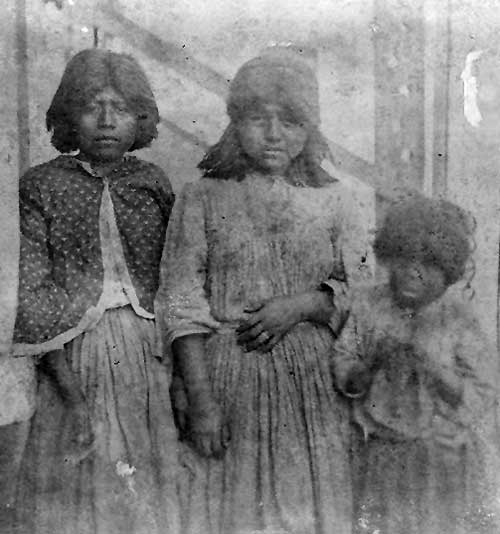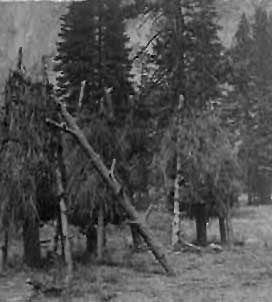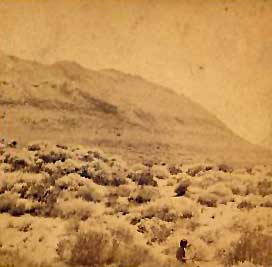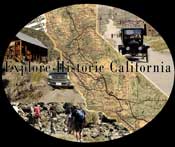Long before the explorers stepped foot on California soil,
Native Americans thrived as hunters and gatherers living off
of natural grown plants for most of their food and material
needs. As Anglos arrived all native people were given the
unflattering term “Digger” as they were observed digging for
roots and gathering acorns. In truth, the “Digger Indians”
were the first horticulturists, with an extensive knowledge
of how to caretake and co-exist in multi ecosystems.
Northern
California tribes were noted for propagating the vegetation
they needed. As basket making materials and food plants were
used up, division and re-plantation techniques were
developed to avoid exhausting much needed supplies. Willow
and redbud for baskets were both harvested faster than the
plants could regenerate.
 |
|
Group
of Digger Indian Squaws circa 1866 by Lawrence &
Houseworth.
Courtesy
Library of Congress collection. |
Succulent and supple sprouts were the most valuable to the
women basket makers. Fire was used to provoke new growth by
burning stiff, knotted old growth. When fire wasn’t
practical, the wild plants of the chaparral were
hand-pruned. Roots, bulbs, and new plants were urged to grow
in greater abundance in new locations.
Out of fifteen species of oak trees that dot the golden
hills of California, only seven were actually used by the
Native Californians for the acorns they produce. The acorn
crop varies from year to year. The valley oak (Quercus
lobata) only produces a heavy crop every third year or
so. Tribes would travel short distances to harvest crops
from alternate species of trees. Elevated granaries of twigs
and brush were constructed to store as much as two years
supply of acorns. Fresh cedar boughs and California bay
discouraged insect damage. Pitch was smeared on supporting
poles of the granaries for rodent control. The black oak (Quercus
kelloggii) in the more mountainous inland regions of
California was relied on during the extremely lean years,
where woodpeckers were observed storing acorns in the large
holes they drilled in the bark.
 |
|
Cashes
or Indian acorn storehouses circa 1875.
Courtesy
Library of Congress collection. |
The digger pines (Pinus sabiniana) grow on coastal
and lower Sierra Nevada foothill ranges, above the oak line
thrive on steep rocky walls of poor ground and on near
vertical cliffs where other foliage refuses to grow. The
large spiked cone of the digger tree was valuable for its'
large nutritious nuts, similar to those of the pinyon pines
which were also harvested.
The meat did not contain tannin, so could be eaten
immediately, unlike the acorn. In the springtime, cones
were beaten off of the lower limbs of the trees with sticks,
while they were still green. The process of beating the
limbs also encouraged new and better growth. The majority of
cones were produced on the higher branches of the tree were
reached by the men who climbed the trees and twisted them
off by hand.
Green cones were pounded until they split apart, nuts
extracted were then pounded into meal or roasted whole. The
bare core of the cone that remained was roasted in hot ashes
for twenty minutes or more for its' sweet syrupy food. In
the fall, mature cones fallen from trees were gathered and
dropped into a fire to burn off pitch. The cone was
destroyed to release the nut which was cracked for meat and
then roasted.
Even the dead digger pines provided useful, for it’s thick
bark was easily separated from the trunks, and could be used
for the conical huts which provided housing instead of tents
made from hides of animals.
Desert dwelling Native Americans relied on sagebrush and
mesquite. Sage leaves were crushed and rubbed onto corpses
to ward off ghosts, and to make mourning necklaces to
discourage dreaming of the dead and undoubtedly helped in
control of decaying odors. The scented foliage also helped
control odors in dwellings, and was used to control fleas
and ticks in beddings.
 |
|
Sagebrush covered desert landscape from original
stereograph circa 1867-1869 by Timothy H.
O'Sullivan.
Courtesy
Library of Congress collection. |
The mesquite tree proved valuable for it’s nutritious pods
which contained 25% sugar. Pod and beans were eaten together
after being pounded and allowed to become sticky, then
rolled into compact balls for the original travel
convenience meal. The Cahuilla tribes encouraged new growth
on mesquite trees by breaking off the less productive
branches to help grow more beans. The new growth at lower
trunk levels was encouraged for easier harvest, as well.
Groves of mesquite trees were set on fire for mistletoe
control, and to promote more new growth. The fires also
thinned the trees, providing less competition for limited
water and nutrients in the harsh desert ground.
California Native Americans proved to be proactive in
environmental control for food and material production,
using natural methods and indigenous plants. Water was often
scarce, and irrigation was virtually unpracticed, except in
rare instances, but common California species were well
adapted to the environment and thrived on what water nature
could offer.
History shows us, however, that the most primary tool
available for horticultural purposes was fire, and this use
was observed and recorded in early Spanish explorer journals
and diaries. Even in areas where animals were available to
supplement natural vegetation for food supplies, fire proved
useful to thin out and encourage new improved plant growth.
Not only was visual distance and movement facilitated in
burned areas, but game populations were increased as more
food sprouted on fire-burned ground. While not farmers or
horticulturalists in the traditional sense of the word, the
California Native Americans were far more than just
“diggers” taking from the land and not reaping. We still
have much to learn from them today.
Bibliography
Redwoods and Roses, The Gardening Heritage of
California and the Old West
by
Maureen Gilmer
Taylor Publishing 1995
Out of Print
Images of Native Californians and acorn cache
Courtesy Library of Congress collection
http://www.loc.gov/pictures/
